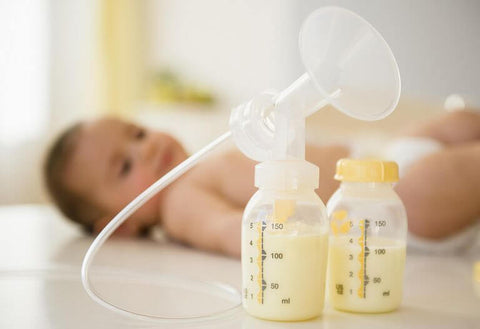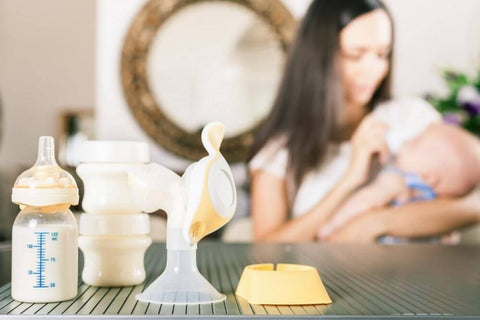We’ve all been there - standing in the baby gear aisle feeling totally overwhelmed by the breast pump options. I distinctly remember my first experience bringing home what felt like a mini milk factory to try and figure out. Between the bottles, tubes, valves, and countless parts - I kept thinking “am I really qualified to put this thing together?!”
But having the right info goes a long way in getting comfortable with pumping. After many sessions with my trusty pump, I’ve learned some key lessons that make the process MUCH smoother. Whether you just started your breastfeeding/pumping journey or you’re a seasoned mom looking for a refresh, stick with me through these must-know tips!

Tip1: Putting the Puzzle Pieces in Place
When opening that box for the first time, the different components can seem confusing and daunting. Let’s break it down:
- Flanges/Breast Shields - These are the funnel looking pieces that go over your breast to extract the milk. Comfort is key!
- Valves - Responsible for making sure milk only flows one-way into the bottle or bag. Don’t skip them!
- Tubing - Carries the precious milk from flange to storage bag or bottle. Securely attached = no spills!
- Bottles/Storage Bags - Where the liquid gold ends up! Pick your container of choice.
Following the visual diagrams in your breast pump’s instruction guide removes ALL the guesswork when putting the essential parts in place. Improperly attached or aligned components can totally change ease of pumping, output volume, and even your milk supply. So refer back to the product manual often in those first few session to ensure the setup clicks!
Over time, assembling your pump correctly becomes second nature. But stay diligent checking for cracks, tears, and leaks that signal replacing worn out parts. Keeping gear in top shape guarantees smooth pumping sessions.

Tip 2: Flange Fit Makes All the Difference
You need the right size flanges aka breast shields. I cannot stress this enough, mama! Up there with milk supply, flange fit impacts pumping comfort the most. Yet many women stick with the standard size included with their pump not realizing better options exist. Don’t just assume one-size-fits-all - take a few minutes to check your flange fit first.
Flange fit checks make pumping comfortable and productive simultaneously. Perform regular size checks following the easy 3 step measuring method below. Both you and baby reap rewards when equipment aligns with YOUR unique anatomy!
Use this measure method to determine proper flange size:
- Express some milk orsimply rub nipple/areola area with a warm cloth to stimulate blood flow.
- Use a flexible tape measure to run across the fullest part of your nipple and then across the fullest part of your areola.
- Compare measurement in mm to flange sizing chart for your pump brand.
Finding your optimal custom flange size has HUGE benefits:
Increased Milk Output - When flanges contour perfectly to your breasts, more ducts drain freely boosting output per session. Snug fit equals fully emptied breasts!
- Prevent Oversupply & Engorgement - Well-fitted flanges drain just enough preventing painful engorgement between pumps. No more rock hard melons!
- Nipple Protection - Good flange fit shields nipples/areola from damage improving comfort long-term. No more dreaded cracking, blistering or bruising!
- Decreased Risk of Infection - Optimized emptying at perfect size lowers chance of mastitis. Say bye to painful clogged ducts and swelling!
- Reduced Stress on Breast Tissues - Ideal fit relieves strain preventing stretched ligaments over time. Phew - no more sag!
Voila! Now you have your magic number and can order the correctly sized flanges. If the flange is too small and pumping is terribly uncomfortable even leading to tissue damage, or the flange is too big and your breasts aren’t properly stimulated reducing output. The right sized flange will definitely enhance your experience of breast pumping.
One last tip: many mamas don’t realize flange fit can fluctuate as breast size/shape changes over the course of breastfeeding. So re-check every 1-2 months to keep that comfort level high!
Tip 3: Hygiene, Hygiene, Hygiene
Cleanliness equals happiness, healthy mama and baby. Especially with equipment gathering your milk supply. Before those new pump parts touch precious breast skin and milk ducts - wash thoroughly with hot, soapy water. Air dry the set fully then reassemble.
I always sterilize flanges, valves, bottles, etc before first use too. It only takes 10-15 minutes either using a sanitizing machine or good ol’ boiling water method. This extra step eradicates lurking bacteria ensuring my pump parts start totally fresh and sterile.
Get into a solid cleaning routine after every pumping session as well. Those little nooks and crannies of valves/tubing can collect unseen milk residue. Following your breast pump guidelines, take apart components and wash/sterilize. Don’t have energy to sterilize every time? At LEAST once daily keeps germs away.
Disinfecting pump parts regularly protects your milk supply for baby AND safeguards your precious boobs from potential infection and mold. A few extra minutes maintaining gear today gives you weeks and months of smooth sailing ahead. Stay consistent on the cleaning regimen - your future self will thank you!Welcome to click Understanding Breast Pump Functionality to learn more about pump cleaning.
Tip 4: Start Suction Slow and Low
When prepping your pumping station - bottles lined up, flanges locked and loaded - we often crank machines to max speed eager to efficiently drain milk faster. Woah, slow down!
Begin each session on the lowest setting, only SLOWLY increasing vacuum strength until output flow starts. Low levels mimic baby’s early nibbles stimulating milk ejection reflex. Starting here prevents shocking your breasts with overly aggressive suction right off the bat.
Watch for signs you have the intensity set too high:
- Discomfort / Sharp Pain in Nipples
- Breasts Feel Overly Stretched by Flanges
- Red Marks on Breast Skin After Pumping
Trust me, join team gentle suction! If you do not know which to choose, you can read Finding the best breast pump fit for You, I believe it can give you a pertinent advice.You want to find that sweet spot level bringing satisfying relief as milk lets down without going overboard into pain territory. Minimal discomfort while reaching your precious oz goal = pumping success!
As your body adjusts session to session, experiment with higher intensities and various vacuum/cycle options. But kick off on mellow mode first. Fiddle those settings until it feels just right, mama!

Pump Smarter, Not Harder!
Whew, who knew so much went into effectively running these high-tech breast milk machines?! Over my own pumping journey, these 4 tips radically improved my experience:
- Correctly assemble ALL parts from bottles to tubing. Consult instructions often until assembly clicks!
- Get professionally FIT for flanges or measure/size yourself properly. Comfort = everything.
- Stay CONSISTENT on cleaning/sterilization before first use + after every session. Hygiene maintains supply!
- Always start suction slow and low, then increase to efficient levels that feel right. High intensity not required!
Give yourself grace figuring out pumping while adjusting to life with a new baby. You’ve SO got this! But also give your pump a fighting chance by following best practices from the start. Once assembled, cleaned, and programmed correctly pumping feels like a total breeze.
Now...go relax and cuddle that precious babe while your pump does the work for you! You deserve it mama. Still have questions on seamless pumping? Drop them in comments below!














Comentarios (2)
Amira Ayari
I’m happy to use
Alyssa Patterson
The inside of the battery where it attaches to the cup has started to smell, I’ve cleaned it out a few times, but is there a way to stop milk from going in there? Or is there something I’m doing wrong?